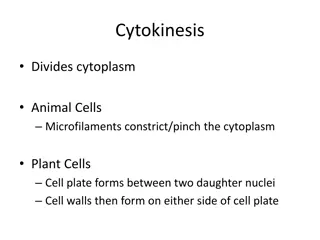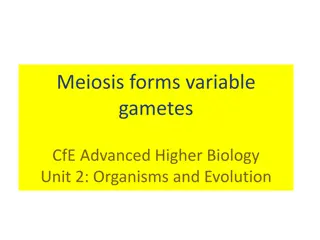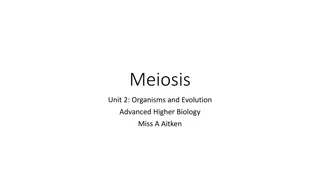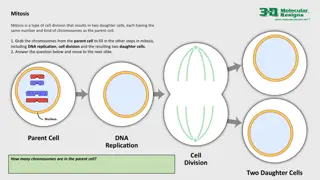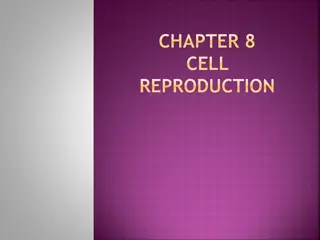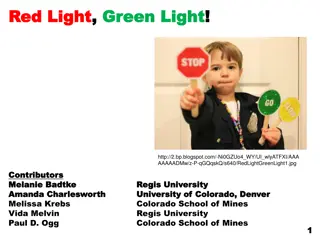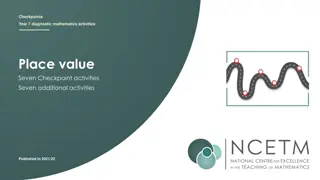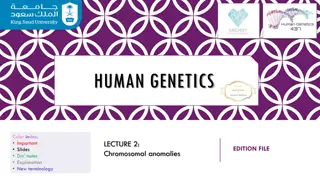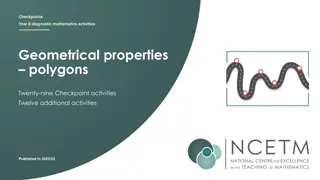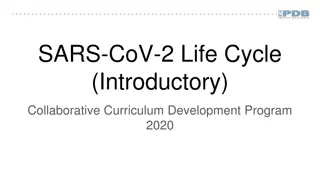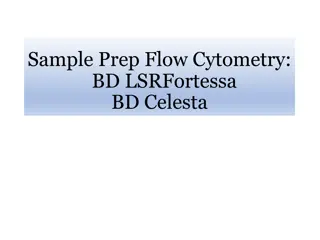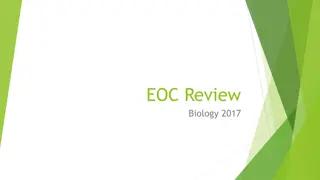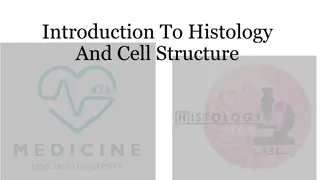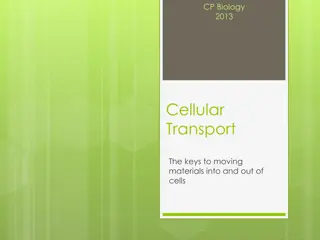Cell Cycle Checkpoints and Meiosis Overview
Cell cycle regulation involves checkpoints at key stages like G1/S, G2/M, and M to ensure proper progression or halt if needed. Cancer cells disrupt this control, leading to uncontrolled proliferation. Meiosis involves two successive divisions, resulting in the reduction of chromosome number and genetic diversity through crossing over and segregation.
Download Presentation

Please find below an Image/Link to download the presentation.
The content on the website is provided AS IS for your information and personal use only. It may not be sold, licensed, or shared on other websites without obtaining consent from the author. Download presentation by click this link. If you encounter any issues during the download, it is possible that the publisher has removed the file from their server.
E N D
Presentation Transcript
Checkpoint control Checkpoints determine whether cell cycle proceeds or is halted (checks to make sure cell is ready to keep going, checking for errors in replication, growth or division) Checkpoints at G1/S; G2/M; and M When good cells go bad: Cancer cells ignore normal signals of cell cycle and undergo rapid proliferation
Stages of Meiosis Meiosis I Is reductional (ploidy goes to n as homologous chromosomes separated) Prophase I pairing of homologous chromosomes and crossing over (to increase diversity in offspring) Metaphase I, Anaphase I, Telophase I Direct No interphase/ replication (G1/S/G2) between Meiosis I and II Meiosis II is equational (ploidy stays at n as sister chromatids separate) Prophase II, Metaphase II, Anaphase II, Telophase II
Class Question chromosomes chromosomes
Diversity of Gametes (Life) Comes during Prophase I Crossing Over -look at chromosome level -will look at DNA level in Lab #12 (and Anaphase I) Law of Segregation
Prophase I Can be broken into 5 substages: 1. Leptonema: Thin threads, Initial stage of condensation 2. Zygonema: Synapsis of homologous chromosomes (Tetrads formed but not seen) 3. Pachynema: Recombination (crossovers) fully started; checkpoints 4. Diplonema: Tetrads fully visible; Chiasma place of crossover is evident 5. Diakinesis: all chiasma have terminalized Degree of condensed chromosomes Remember, DNA was already replicated in S phase, as chromatin condenses, begin to see all 4 chromatids of tetrad
Prophase I Will see differences in slides in lab
Chromosome/DNA terms ploidy: deals with the number of sets of chromosomes haploid = 1n = one set of chromosomes, diploid = 2n = two sets of each chromosome, etc C-value lowest amount of genomic DNA found in a cell of an organism (ie haploid cell) 1C = DNA content in haploid etc gametes somatic cells
Class Question Animal has n=2 value. Can you indicate n- and c-values for a diploid cell during all stages from G1 through end of mitosis? Through end of meiosis? Know for quiz
Genome size and organisms No correlation between # chromosomes and complexity of an organism (n-#) Little correlation between genome size and complexity (c-#)
Animals - Spermatogenesis Signal to enter cell cycle spermatogonium 2n Primary spermatocyte 2n Secondary spermatocytes Meiosis II Spermatids n Differentiation 4 gametes produced per spermatagonium Spermatazoa
Maturation of Sperm Most of cytoplasm eliminated, DNA repacked Centrioles become basal bodies, form flagella Internal structures moved (ie mitochondria) to power movement
Animals - Oogenesis Signal to enter cell cycle Oogonium 2n Primary oocyte 2n Unequal division of cytoplasm May or may not go through division First polar body Secondary oocyte Meiosis II Unequal division of cytoplasm Second polar body Ootid Differentiation Only 1 gamete produced per oogonium Ovum
Progression of Oogenesis Timing: Mammals: designation starts before birth At birth, all eggs to be produced are arrested as Primary Oocytes in Prophase I Puberty triggers development and release of an egg/month Other cases: Ascaris (roundworm) Sperm interacts with egg when it is still only a primary oocyte. Sperm pronuclei waits around in egg as egg completes both divisions of meiosis
Plants Alternation of generations Sporophyte (2n plant tissue) Meiosis produces haploid spores (n) microspores (made in anthers) megaspores (made in ovule) Mitosis of spores then produces gametophytes (n) for fertilization and recreation of sporophyte (2n) state (text: Fig 7.2; pgs 165-167)
male Microsporogenesis gametophyte pollen tube nuclei all 4 mature Pollen Mother cell (anther) mitosis no cytokinesis only karyokinesis meiosis mitosis only kk generative nucleus microspores microspore sperm nuclei + Why 2 sperm nuclei? differentiation of surface coat creates pollen grain containing male gametophyte Megasporogenesis female gametophyte only 1 functional Megaspore Mother cell (ovule) mitosis only kk mitosis only kk mitosis only kk meiosis megaspore 8 nuclei in female gametophyte megaspores Pics from http://home.cc.umanitoba.ca/~frist/PLNT3140/l03/l03.4.html
http://home.cc.umanitoba.ca/~frist/PLNT3140/l03/l03.4.html Plants Double Fertilization seed pollen transferred from anther to stigma causes male pollen tube nuclei to develop pollen tube down style to ovary/ovule to carry sperm nuclei to female gametophyte 8 nuclei in female gametophyte + 2 sperm nuclei 3 Antipodal and 2 synergid nuclei eventually degenerate 1 Egg nuclei (female) merge with 1 sperm nuclei (male) to make 2n (diploid) embryo 2 polar nuclei (female) merge with 1 sperm nuclei (male) and create 3n (triploid) endosperm Endosperm serves as food source for growing embryo
For Next Time Quiz on Mitosis/Meiosis Stages Drawings n-/c-values animal/plant terminology


